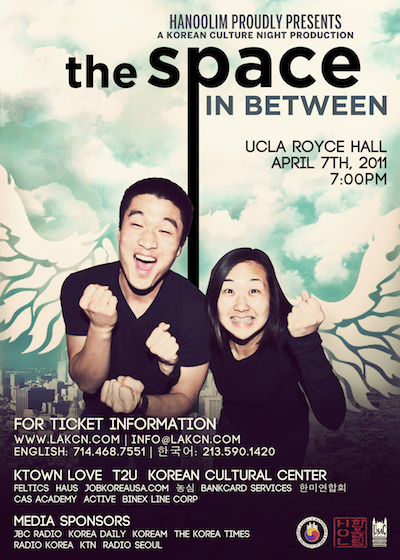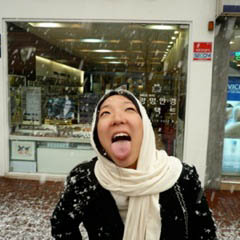A generation of youth who were toddlers, or not even yet born, at the time of the 1992 Los Angeles riots embraces this seminal piece of Korean American history in a new production at UCLA.
by Elizabeth Eun
photographs by Jeremiah Choi
When Los Angeles exploded in fires and violence in April of 1992, in one of the worst riots in United States history, Hannah Cho was just 3 years old and living in Taipei, Taiwan. The Korea-born toddler didn’t even have an inkling of the crisis enveloping this distant city, let alone an understanding of the complexities of how economic disenfranchisement, criminal injustice and institutional racism bred the conditions for such an event.
Eighteen years later, Cho would watch Sa-i-gu, a documentary about the riots (directed by Dai Sil Kim-Gibson and Christine Choy), in an Asian American studies class at UCLA and was stunned. It was not only the stark contrast of her perception of the city she now calls home to the images of flames and destruction pictured in the documentary that moved her, but also the strength and resilience of the Korean women—grandmothers, mothers and daughters—on whom the film focused. Though all were directly affected by the riots either as shopkeepers who lost their businesses or even one mother who lost her son to the violence, they picked up the pieces and rebuilt their businesses and lives.
“The number one reason I [was moved] was because I [have a] Korean American identity,” said Cho, who immigrated with her family to the United States at age 5. “I felt like this was a story about me.”
 The 22-year-old is hoping other students will share this collective sense of ownership of the riots—which some community leaders have called Korean America’s “baptism by fire”—and embrace “The Space in Between,” a play she penned that was inspired by the Sa-i-gu documentary. The play—which follows the lives of an elderly Korean immigrant woman who owned a liquor store in the heart of Koreatown in 1992, her daughter and granddaughter—will serve as the centerpiece of this year’s popular UCLA Korean Culture Night, a show also featuring Korean drumming and dance performances, produced by Hanoolim, the campus’ Korean culture awareness group.
The 22-year-old is hoping other students will share this collective sense of ownership of the riots—which some community leaders have called Korean America’s “baptism by fire”—and embrace “The Space in Between,” a play she penned that was inspired by the Sa-i-gu documentary. The play—which follows the lives of an elderly Korean immigrant woman who owned a liquor store in the heart of Koreatown in 1992, her daughter and granddaughter—will serve as the centerpiece of this year’s popular UCLA Korean Culture Night, a show also featuring Korean drumming and dance performances, produced by Hanoolim, the campus’ Korean culture awareness group.
“Because college students now, my peers, don’t remember [Sa-i-gu] or only know bits and pieces that their parents or aunts and uncles talked about, I thought it would be a good time to bring it up again, especially since next year is the 20th anniversary,” said Cho, a senior studying international development studies.
“I’m focusing [the play] more on the relationships that were happening during this time, and the hope and strength and trust that was required for everyone to move on.”
And Cho’s story of hope following tragedy will certainly have a sizable audience when the curtains go up April 7 at UCLA’s Royce Hall. The annual Korean Culture Night, produced entirely by a team of about 90 students, may just be the nation’s largest campus-based, student-run cultural show, and consistently sells out its 2,000 seats. The executive team works for an entire year—the planning process for next year begins almost immediately after the show ends—while the cast begins rehearsing a full semester before the show. The production’s budget, estimated at roughly $70,000, far exceeds a year’s tuition and boarding fees. Because the student group gets no funding for the show from the university, it solicits financial support from the Los Angeles Korean American community, receiving consistent donations from such businesses as Asiana Airlines and the Kim Sun Young Beauty Salon chain. Students also literally take to the streets to fundraise, with members of Hanoolim’s poongmul team walking through Koreatown, playing their drums and collecting cash donations.

Although the annual show has enjoyed great success in community support over the years, the students said, thanks to this year’s Sa-i-gu theme, they noticed a surge in interest and donations. “[The finance team] has said that a lot of the past sponsors and the new sponsors are really pleased because [Sa-i-gu is] such a relevant issue to them, but it’s such a forgotten event,” said Mina Lim, a senior studying sociology and the associate producer of the Korean Culture Night. “There’s also a concern that we portray it accurately.”
Toward that end, as part of her research, the play’s brainchild interviewed firsthand sources, including her own aunt and uncle, who ran a liquor store in Koreatown during the riots. After the store was looted and damaged, the couple decided to leave Koreatown and open a business in Torrance, about 20 miles south of Los Angeles—with bulletproof glass separating the customers from them. Cho also interviewed her fiancé’s grandparents who were forced to close their Koreatown restaurant after the riots due to a dramatic drop in business.
“It was kind of shocking to me how devastating it really was for them because right now, I can’t even imagine something like that happened to them, by the way they live and how happy they are now,” said Cho of her fiancé’s family. “I wanted to show this story to shed light on what our parents and grandparents have done for us, so we as a generation can understand that and honor them,” she added. “Everyone’s story is different, but hopefully it’ll get [my generation] to start thinking about it and start some dialogue.”
To reserve free tickets for the show, email your first and last name to info@lakcn.com.





